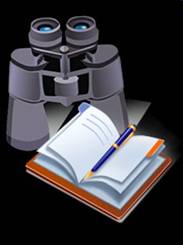Field Animal Behavior
EEB 3898: Field Animal Behavior
May Term, May 13th - 31st, 2013 MTWThF 1-4pm Torrey Life Sciences, Rm 181
Instructor: Dr. Kristiina Hurme
Office: TLS 379
Phone: 860-486-5434
Office hours: variable & flexible (call, email, drop by)
Course Objectives
➢ Learn how to observe animal behavior
➢ Notice animal behavior in our daily lives
➢ Learn how to take field notes
➢ Learn and apply basic field techniques, study design, and data analysis
➢ Develop a research project
➢ Improve collaboration skills
Course Materials
• Required
o Binoculars (available from us if you don’t have any)
o Field notepad/notebook
o Watch with countdown timer that beeps
o Closed-toe shoes (no sandals) or hiking boots, & proper outdoor clothing (poison ivy, weather)
• Recommended
o Field Guides (birds, mammals, insects, etc.) for New England or Eastern US
o Camera
o Insect repellent (ticks, mosquitoes)
o Sunscreen, sunglasses, hat
Tentative* schedule
*: Schedule is subject to change pending weather conditions, or unforeseen observation and research opportunities.
Grading
Exams: May 22nd (MIDTERM) [50 points]; May 31st (FINAL) [50 points]
Project Paper:
May 21st (Intro and Methods) [30 points];
May 30th (Final) [50 points]
Project Presentations:
May 21st (Intro and Methods) [20 points];
May 29th (Final) [25 points]
Field Notebook Submissions:
May 20th (First) [20 points];
May 28th (Final) [25 points]
Field trips = Birding exercises (5 points each):
Dates will be weather dependent [30 points]
Total: [300 points]
Grading scale: A = 100-90%, B = 89-80%, C = 79-70%, D = 69-60%, F = 59-0%.
Plus/minus system will be used for the final grade.
Additional References & Websites
• Eastern Forests: A field guide to birds, mammals, trees, flowers, and more. Peterson Field Guides.
• Stiling P. 1999. Ecology: theories and application. New Jersey: Prentice Hall.
• Clark, G. A. 1999. Birds of Storrs, Connecticut and vicinity. 3rd Ed. Mansfield, CT: Natchaug Ornithological Society & Joshua’s Tract Conservation and Historic Trust.
• SORA (Searchable Ornithological Research Archive): http://elibrary.unm.edu/sora/index.php
• Cornell Lab of Ornithology “All About Birds”: http://www.birds.cornell.edu/AllAboutBirds
• Natchaug Ornithological Society: http://www.nosbird.org/ (esp. “local hotspots” http://www.nosbird.org/hotspots.html)
• Connecticut Ornithological Association: http://www.ctbirding.org/index.htm
• CT Audubon Society: http://www.ctaudubon.org/
• CT Department of Environmental Protection: http://www.ct.gov/dep/site/default.asp
Website design by Diego Sustaita

